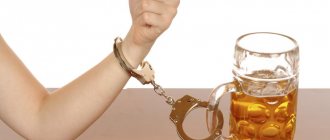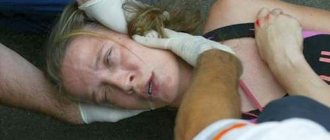What it is?
Alcoholic polyneuropathy, whose ICD code is 10: G62.1, is called extensive damage to nerve cells by ethanol toxins. The pathology is diagnosed in people with chronic alcohol addiction. It happens in patients with acute ethyl poisoning.
Alcohol toxins have an extremely negative effect on the human nervous system. By destroying the myelin sheath and nerve fiber, they lead to all types of sensory disturbances. Such exposure leads to the development of alcoholic polyneuropathy, the symptoms of which suggest that this is an extremely serious disease that worsens the patient’s quality of life and leads to disability.
Characteristic signs of alcoholic polyneuropathy:
- refers to complications of alcohol intoxication;
- occurs more often in acute or subacute form;
- multiple neuronal damage (affects the entire nervous system or large areas of the nervous system);
- as a result of toxic effects, metabolism in neurons is disrupted;
- metabolic disorder causes dysfunction of the peripheral and/or central autonomic nervous system;
- damage to the nervous tissue of the central nervous system (in the brain and spinal cord) is rare;
- a person loses his ability to work and receives group II disability;
- with adequate treatment, ability to work is restored;
- refusal of therapy ends in death.
According to statistics, severe alcoholic polyneuropathy develops in 30% of men and 10% of women with addiction. During a comprehensive examination of the body using electroneuromyography, damage to the nervous tissue is detected in all chronic alcoholics. That is, the frequency of occurrence is 97–100% in addicted people, but the disease occurs in a latent (asymptomatic) form.
Reference! Letts was the first in history to describe the symptoms of the disease in 1787 when he discovered neuropathy of alcoholic origin in patients with addiction.
Symptoms of polyneuropathy
Toxic neuropathy or atrophy of the muscles of the limbs makes itself felt gradually with slight numbness and a tingling sensation. The first symptoms of polyneuropathy do not cause much concern for some time, but if the development of the neurological disease is not stopped and the fight is not started, this will inevitably lead to paralysis of the legs and speech disorder. The main signs of toxic polyneuropathy are as follows:
- muscle tension, slight numbness of the limbs;
- weakness in the legs;
- convulsions;
- excessive sweating;
- cyanosis of hands and feet;
- speech disorder;
- dry skin, the appearance of ulcers;
- burning sensation;
- disorientation.
Causes
The metabolic process in neurons is disrupted by the toxic effects of ethyl alcohol and its breakdown products (metabolites, acetate) on the nerve cell. Polyneuropathy occurs in people with the last stage of chronic alcoholism or after prolonged heavy drinking. The disease can worsen due to hypothermia.
Alcoholic polyneuropathy can be triggered by:
- consumption of low-quality alcoholic beverages;
- inability of the body to neutralize toxins (genetic disorder, debility, old age, oncology);
- vitamin deficiency, lack of useful micro- and macroelements;
- deficiency of B vitamins or thiamine (B1) or folic acid (B9);
- hepatitis, liver cirrhosis;
- metabolic disorder.
Alcoholic polyneuropathy occurs in people without addiction if an excessive dose of alcohol is drunk or a fortified drink is consumed by a child or teenager. These are isolated cases, the pathogenesis is being studied. With a single ethanol intoxication, nervous system disorders remain due to self-medication or lack of medical care.
Causes of alcoholic polyneuropathy
Numerous studies indicate that over 75% of the total number of identified cases of neuropathy are caused by the body’s response to long-term (from 5 years) consumption of drinks containing ethyl alcohol. The severity of the disease is directly related to the amount of ethanol regularly consumed by a person.
The reasons that provoke the development of neuropathy include:
- toxic effects of alcohol on nerve fibers;
- hypoxia;
- disruption of the digestive tract (liver, intestines), immune system;
- poor nutrition;
- decreased blood levels of magnesium and potassium;
- thiamine (vitamin B1) deficiency.
Additional conditions that cause various forms of the disease are genetic predisposition (including increased vulnerability of nervous system tissues) and autoimmune processes.
Alcoholics are characterized by prolonged exposure to a monotonous position (during sleep) while simultaneously losing sensitivity to pain. This condition is fraught with the appearance of numbness and the development of prolonged compression syndrome, leading to compression-ischemic neuropathy.
Forms
The classification was based on the clinical manifestations of the disease. Multiple neuronal damage can be asymptomatic, acute, subacute and chronic. Depending on the type of alcoholic polyneuropathy, the patient is diagnosed with different symptoms and different treatments are prescribed. The first and last varieties occur with prolonged alcoholism, and the rest - in people with long-term drinking.
Forms of neuropathy according to clinical signs:
| A type of alcoholic polyneuropathy | Distinctive features |
| Sensory | Defects in skin sensitivity in the extremities are detected. Accompanied by pain. |
| Motor | Characteristic disorder of reflex-motor function |
| Mixed (combined) | There are simultaneously signs of sensory and motor forms of polyneuropathy |
| Pseudotabetic (atactic) | Characterized by incoordination of movements, clinically similar to tabes spinal cord |
| Subclinical (initial) | There are no obvious disturbances: the neurons are just beginning to be damaged. Reflexes, motor skills and/or sensitivity are slightly impaired. |
| Vegetative | The cells of the ganglion (autonomic) nervous system, which regulates the body’s activities, are affected. Manifested by dysfunction of glands, blood vessels, and organs. |
Polyneuropathy of the lower extremities
Most often, the pathological process affects the nerves and vessels of the lower extremities. Due to too much stress, they are the most vulnerable, so destructive disorders in the nerve fibers occur faster, leading to sensitivity disorders, pain, vascular diseases, and lameness. Alcoholic polyneuropathy of the lower extremities if left untreated can lead to severe complications due to which patients lose their ability to work and the ability to care for themselves.
Polyneuropathy of the upper extremities
Alcoholic polyneuropathy of the upper extremities occurs in patients with long-term addiction. It can also occur after a single use of large doses of ethanol. It is also accompanied by sensory and motor disturbances.
Reference! According to clinical signs, the forms are the same for all types of toxic damage to nervous tissue. There are no differences in dysfunctions of the nervous system in case of poisoning with alcohol, medicine, poison, or other harmful substance, so the cause is identified by tests.
Forms of the disease
Experts classify alcoholic polyneuropathy into several groups. The basis for systematization is the clinical picture of the disease and the rate of its progression.
According to the nature of the course, polyneuropathy is divided into three types:
- chronic, developing over 12 months or longer;
- acute, characterized by a rapid (up to 30 days) rate of formation;
- subacute
Most often, specialists identify the first of these types of disease.
Also, alcoholic polyneuropathy, in accordance with its clinical manifestations, is usually differentiated into 4 groups.
- Mixed, one of the most common. The disease affects the upper and lower extremities. Symptoms include paralysis of the hands (feet), hypotension, decreased deep reflexes, atrophy of the muscles of the forearms, and an altered (minimized or increased) level of sensitivity in the affected areas.
- Sensory, characterized by the appearance of pain in the locations of large nerves, a burning sensation, chilliness, and numbness of the feet. With polyneuropathy of this type, convulsions and vegetative-vascular pathologies (marbling of the skin, acrocyanosis, hyperhidrosis) are also observed.
- Motor, characterized by dysfunction of the extensors of the fingers and distal legs due to the development of changes in the common peroneal and tibial nerves. Plantar flexion, walking on toes, and counterclockwise rotation of the foot are difficult.
- Atactic (the second name for the form of alcoholic polyneuropathy under consideration is peripheral pseudotabes). Its signs are: numbness of the legs, the appearance of pain when palpating the affected areas, impaired coordination of movements and gait.
A number of researchers distinguish autonomic and subclinical types of neuropathy.
In chronic alcoholism, the disease may be asymptomatic.
Symptoms
Symptoms of neuropathy caused by alcohol intoxication depend on what form of the disease the patient has. The disease manifests itself as a disorder of the functions of the nervous system. If neurons in the spinal cord or brain are involved, signs of mixed autonomic polyneuropathy are more often observed. When the cells of the peripheral nervous system are damaged, the development of one type of disease is noted: sensory, motor, or combined.
General Neuropathy Clinic
Initially, a person notices pain in the nerve trunk and adjacent muscles, which intensifies with pressure. Later, paresthesia appears: a spontaneous feeling of goosebumps, tingling, burning in the limb.
Alcoholic polyneuropathy is often accompanied by:
- decrease, memory loss;
- mental disorders;
- swelling of joints, feet, hands;
- damage to the oculomotor, vagus, phrenic nerve;
- impaired vision (alcoholic amblyopia), breathing, vascular function, and internal organs.
As it progresses, paralysis of the extensor or flexor muscles occurs. The affected muscles quickly atrophy. At the beginning of development, the reaction of tendon reflexes increases, then disappears or remains enhanced. The superficial sensitivity of the hands and/or feet changes from the fingers to the knees and elbows.
Alcoholic polyneuropathy progresses sharply or over weeks or months. During treatment, a reverse development occurs: the nervous system is fully or partially restored.
Subclinical symptoms
The initial stage of alcoholic polyneuropathy is detected by instrumental examination. Symptoms are not expressed. Fingers begin to feel chilly, fine motor skills and sensitivity in the arms and legs deteriorate. The disease progresses slowly unless the person goes on a binge. The first sign of development is pain in the nerve when pressing on the area where it lies.
Motor form symptoms
With this type of alcoholic polyneuropathy, motor ability is reduced. The muscles weaken, paresis or paralysis of a particular muscle group occurs. The clinic is supplemented by signs of sensory disorders (“goosebumps”, changes in sensitivity, etc.). Movements also slow down.
The knee reflex usually increases and the Achilles tendon decreases. If the fibers in the tibial nerve are damaged, they begin to walk on their toes, and plantar flexion of the foot is impaired.
Signs of damage to the peroneal nerve:
- the functions of the extensor muscles deteriorate;
- muscle tone and volume decrease in the foot and lower leg.
Reference! Most often, doctors identify mixed alcoholic polyneuropathy. Symptoms of the motor + sensory variety are present, nerves in the arms and legs are involved, and muscles in the extremities atrophy.
Signs of sensory form
Damage to the tissue of the peripheral nervous system is more often observed in the legs, less often in the arms. The sensations spread from the fingers up to the limbs.
For sensory alcoholic polyneuropathy:
- cramps in the calf muscle become more frequent;
- burning pain is felt along the area of the major nerve;
- tingling and itching is felt in the limbs;
- chilly hands or feet;
- arms/legs become numb, muscles lose strength;
- tendon reflexes, in particular the Achilles reflex, decrease;
- in the palms/feet and higher up the limb, temperature and pain sensitivity increases or disappears.
Sensory impairment is often accompanied by motor and autonomic disorders. Doctors detect increased sweating. On the hands and feet, the skin color becomes marbled or bluish. Trophic ulcers form.
Signs of the pseudotabetic form
Sensitive ataxia develops. She is characterized by loss of coordination of movements and unsteady gait. When you feel the area where the nerves lie, acute pain occurs. The sensitivity of the skin in the palms, forearms or feet, legs decreases.
With alcoholic atactic polyneuropathy, there are no diabetic crises, syphilis and Argyle-Robertson syndrome. There are no “lumbago” or other signs of tabes dorsalis.
Symptoms of the vegetative form
The ganglion division of the NS regulates the reflex functions of internal organs, glands and blood vessels. Alcoholic polyneuropathy is often accompanied by disorders of the heart, circulatory and genitourinary systems.
Possible symptoms of the vegetative form:
- irregular myocardial contraction;
- dizziness, fainting;
- drop in pressure when changing position (orthostatic hypotension);
- deterioration of sexual desire;
- erectile dysfunction in men;
- women stop having orgasms;
- urinary incontinence;
- vomiting or persistent nausea;
- increased sweating;
- diarrhea;
- flashing dots before the eyes.
Reference! Vegetative signs appear expressed or weakly in other forms of this disease. They are also similar to symptoms of progression of alcoholism.
Symptoms of alcoholic neuropathy of the lower extremities
Alcoholic polyneuropathy of the legs is accompanied by a violation of skin sensitivity: a feeling of crawling sensations, numbness. The skin of the legs becomes bluish and cool to the touch. Patients constantly feel cold in their feet. Neuropathy of the lower extremities, in which alcohol intoxication develops faster than in the arms, without treatment leads to intermittent claudication, pain when walking and at rest, and vascular inflammation. Due to the severity of the symptoms, this form of the disease is diagnosed most often.
Symptoms and diagnosis
The initial stage of polyneuropathy is characterized by the absence of significant signs. The further development of the process is characterized by a gradual loss of compensatory capabilities, the occurrence of muscle pain and weakness. Up to 50% of diseases (of the total number of ailments) first affect the legs and then spread to the arms.
Diagnostics
To establish that the identified neuropathy is alcoholic, it is important to diagnose the patient’s addiction or find out about the alcohol taken before the onset of clinical manifestations. The type of toxic damage to nervous tissue must be confirmed by the results of laboratory tests. This is important because different medications are used to cleanse the body of alcohol, poison, and drugs in case of overdose. To clarify the diagnosis, they talk with the patient’s relatives about his lifestyle and the possible influence of ethanol.
Laboratory methods for diagnosing alcoholic polyneuropathy:
- biochemical blood test;
- biopsy of nerve and muscle tissue;
- cerebrospinal fluid puncture.
Laboratory and cytohistological analysis of the biomaterial helps to detect muscle atrophy and destruction of the myelin sheath in neurons. The neurologist conducts a physical examination (examination, palpation, history taking), and refers to ENMG. Electroneuromyography can detect even asymptomatic damage to nerve fibers.
Diagnosis of polyneuropathy
Diagnosis of lower extremity neuropathy begins with collecting information about the patient. The symptoms described above can signal many other pathologies, which can often be excluded at the stage of communication with the patient.
At the next stage, an examination of the legs is carried out, which reveals the changes that have occurred: muscle weakness, numbness, atrophy and other signs of damage.
To differentiate polyneuropathy from other neurological disorders, electroneuromyography is used. ENMG allows us to identify the degree of damage to nerve fibers, the presence of an inflammatory process and the course of degenerative processes. If a disease is suspected, a biopsy is additionally prescribed to confirm the diagnosis.
Treatment
Treatment of alcoholic polyneuropathy is aimed at cleansing the body of alcohol and breakdown products, regenerating neurons, restoring metabolism and blood supply to tissues. It is strictly prohibited to drink alcohol-containing drinks or medicinal tinctures.
It is important to have a balanced, nutritious diet, consume the amount of fresh fruits, vegetables, protein foods, and water. It is advisable to select the diet and food regimen according to Pevzner’s recommendations for a general diet (treatment table No. 15).
Conservative treatment includes drugs:
- detoxification effect;
- blood glucose regulators;
- neuronal protectors, metabolisms, trophics - “Tanakan”, “Neuromidin”, others;
- antioxidants – “Tiogamma”, “Berlition”, other preparations of thiocotic acid;
- vasoactive drugs - “Halidor”, “Benziclan fumarate”, “Pentoxifylline”, other vasodilators, antispasmodics;
- B vitamins – “Milgammacompositum”, “Berocca +”, “Benfotiamine”, others;
- ascorbic acid;
- antihypoxants - Actovegin.
Medicines to eliminate or reduce the symptoms of alcoholic polyneuropathy are selected individually for the patient. They use sedatives, anticonvulsants "Finlepsin", anticonvulsants "Gabapentin", antidepressants "Paroxetine". To improve brain activity, piracetam is prescribed from nootropic substances.
To relieve pain, anti-inflammatory drugs Meloxicam, Nimesulide, and antispasmodics are prescribed. In case of complications of alcoholism, medications for etiological treatment are prescribed. For liver diseases, the regimen includes hepatoprotectors of plant origin. Cardiac medications are used to support myocardial function.
The main goals of treatment for alcoholic polyneuropathy of the lower extremities are restoration of tissue trophism and prevention of the development of vascular pathologies. For this purpose, vasoactive medications are used, and detoxification therapy is mandatory. To relieve pain, NSAIDs and antispasmodics are prescribed.
Reference! Treatment of alcoholic polyneuropathy at home is impossible. Traditional methods are used only in addition to medications, exercise therapy, massage after consultation with the attending physician.
After eliminating acute intoxication, the drugs “Dibazol”, “Amiridin”, and other drugs with bendazole and ipidacrine are used. The drugs stimulate the transmission of nerve impulses, help the body adapt, increase tone, relieve muscle spasms, and dilate blood vessels. The psychologist talks with the patient about the need to give up alcohol and explains the causes of nerve damage.
During the recovery period, physiotherapy is prescribed. Massage, acupuncture, and electrical muscle stimulation are useful. These methods improve blood circulation and restore sensitivity. After treatment of alcoholic polyneuropathy of the lower extremities with drugs, physical therapy exercises are recommended. This will help restore motor functions and strengthen the body.
Methods for diagnosing the disease
The main ways to diagnose alcoholic neuropathy are by taking a medical history, analyzing complaints about existing symptoms, and examining the patient. They allow us to draw a conclusion about the presence of the disease.
Additional diagnostic methods can only confirm the initial diagnosis, identify the stage and degree of development of neuropathy, as well as other features that enable the specialist to prescribe competent and effective treatment. These examination methods include:
- biopsy of a piece of nerve - taken to analyze and understand the general clinical picture of the disease;
- Electroneuromyography is a hardware diagnostic method that shows detailed features of the disorder and allows you to track the dynamics of the disease.
Prognosis for recovery
The prognosis for recovery is favorable. For recovery, it is important to undergo the necessary therapy and completely stop drinking alcohol. If you refuse treatment or continue to drink alcohol, polyneuropathy causes paralysis. The commission assigns disability group 2. Death is possible due to damage to the nerves “responsible” for breathing, heart function, and brain function. In 50% of cases, a person dies after 10 years.
Quitting alcohol, adequate treatment, daily exercise and massage allows neurons to recover. In case of disability, a transition to group 3 or full recovery is possible. Therapy followed by rehabilitation lasts at least a year.
Signs and symptoms
The signs and symptoms of alcoholic polyneuropathy can progress gradually and are usually subtle at first. Often, a person who drinks heavily may not realize that symptoms are related to alcohol or neuropathy.
Symptoms include any combination of the following:
- decreased sensation in your legs, toes, feet, hands, or fingers;
- pain, tingling, or other unusual sensations in your leg, toes, foot, arm, or fingers;
- weakness of the legs or arms;
- lack of coordination of legs or arms;
- loss of balance/unsteadiness when walking;
- bruises, cuts, sores, or skin infections on the legs, toes, or fingers;
- reducing pain from injuries, especially on the legs or arms;
- dizziness, especially when standing with your eyes closed;
- it is difficult to walk in a straight line, even if you have not drunk alcohol;
- constipation or diarrhea;
- urinary incontinence;
- sexual dysfunction (disorder of sexual desire, sexual arousal).
What do you need to remember?
- With alcoholic polyneuropathy, neurons are damaged and the functioning of the nervous system deteriorates.
- The disease develops due to the toxic effects of ethyl alcohol.
- Alcoholic neuropathy of the lower extremities is the most common form of pathology.
- Among the symptoms, loss of sensitivity of the skin on the extremities and movement disorders are most often observed.
- Diagnosis includes electroneuromyography and laboratory tests.
- Treatment and recovery of patients with alcoholic polyneuropathy of the lower extremities and other forms of pathology is possible only after complete cessation of alcohol;
- Complications include disability, dysfunction of the genitourinary and cardiovascular systems.
- The prognosis is favorable with timely initiation of treatment and complete abstinence from alcohol.
Literature
- Vittadini G., Buonocore M., Colli G., Terzi M., Fonte R, Biscaldi G. Clinic and epidemiology of alcoholic polyneuropathy // Oxford Medical Library. Thematic collection. — Issue No. 2. — 2012. — pp. 23-29.
- Vittadini G., Buonocore M., Colli G., Terzi M., Fonte R, Biscaldi G. Alcoholic polyneuropathy: clinical and epidemiological study // Oxford journals, translated licensed articles on modern medicine. Thematic collection. - 2010. - P. 6-14.
- Khodulev, V.I. Electroneuromyographic characteristics of alcoholic polyneuropathy / V.I. Khodulev, N.I. Nechipurenko, S.V. Marchenko // Journal. neurol. and a psychiatrist. - 1999. - No. 12. - P. 47-49.
- Anisimova, E.I. Clinical and physiological analysis of pain syndrome in polyneuropathies: Abstract of thesis. dis. ...cand. honey. Sciences / E.I. Anisimova. - M., 2002.
- Acute alcoholic polyneuropathy / I.A. Strokov, V.V. Alekseev, I.V. Eisenberg, A.V. Volodina // Neurol. magazine - 2004. - T. 9. - No. 1. - P. 45-50.
- Skoromets, A.A. Nervous diseases: Textbook. allowance A.A. Skoromets, A.P. Skoromets, T.A. Skoromets. — Ed. 2nd, revised and additional - M.: MEDpress-inform, 2007. - 552 p.: ill.
- Alcoholism. Clinical med. / A. Adams, E.L. Goldberg, Hi Green et al. — 2 ed. St. Louis: Mosby, 1996. - P. 747-752.
Recovery period and prognosis
It is impossible to recover from alcoholic neuropathy in a short time. The period of full recovery lasts from 3-4 months to six months.
The main condition for achieving the maximum possible therapeutic effect is a complete abstinence from drinks containing ethyl alcohol.
Small changes that have occurred in the body are completely eliminated. In the chronic course of polyneuropathy, restoration of destroyed nerve fibers does not occur; Modern methods of therapy can only achieve stabilization of the process and a decrease in the severity of symptoms.
Refusal to visit the clinic and receive medical care, aggravation of the pathology by further alcohol abuse will lead to disability. The latter can cause complications such as:
- leg paralysis;
- complete loss of mobility;
- cerebellar damage;
- dysfunction of the central nervous system;
- the occurrence of mental disorders.
Death is also possible (including from cardiac arrest).
Drug and non-drug treatment
A neurological disease manifests itself against the background of regular toxic exposure or after a prolonged binge. Therapy is prescribed taking into account these factors and proceeds in different directions. Common requirements include complete abstinence from alcohol consumption and dietary adjustments .
To restore microcirculation, eliminate pain and improve neuromuscular conduction, the doctor may prescribe anti-inflammatory drugs, antihypoxants, antioxidants, analgesics, and B vitamins.
Drug therapy
Early diagnosis of the disease significantly increases the chances of rapid relief from alcoholic neuropathy of the lower extremities. Treatment is aimed at improving blood flow in the area of nerve endings and restoring the functioning of nerve fibers. Before prescribing this or that drug, the doctor must carefully study the medical history and make sure that the patient does not have allergies.
The following types of therapeutic measures will help improve the patient’s condition:
- use of antidepressants (Venlafaxine, Actovegin, Berlition, Mexidol, Sertraline);
- taking anti-inflammatory non-steroidal painkillers (Meloxicam, Ketoprofen, Nimesulide);
- a course of vasoactive medications (Nicotinic acid, Emoxipin, Instenon, Vazonit);
- vitamins Thiamine, Benfotiamine, group B;
- anticonvulsants (Pregabalin, Gabapentin);
- creams and ointments are used for local anesthesia (Capsaicin, Ketoprofen, Finalgon, Diclofenac, Capsicam).
Physiotherapeutic procedures for neuropathy
Other treatment methods are also used to speed up the healing process. Non-drug therapy includes physiotherapeutic procedures , among which magnetotherapy, as well as electrical stimulation of the spinal cord and nerve fibers, should be especially noted. Massage has also shown high effectiveness, with the help of which it is possible to restore muscle activity. In addition, methods such as mud therapy, physical therapy, and acupuncture are widely used in the treatment of alcoholic neuropathy.
With a combination of physiotherapy, medication and traditional methods of therapy, you can achieve good results and speed up the healing process.
It must be said that polyneuropathy, which is a consequence of alcohol abuse, can be successfully treated only in the initial stages of development. With far-reaching changes and destruction of nerve fibers from the effects of alcohol, complete recovery is impossible. In such cases, you can only stabilize the patient’s condition and reduce symptoms. But this does not mean that treatment is not necessary at all. Lack of treatment and incessant libations can ultimately lead to complete disability and the inability to self-care. This is especially true for people suffering from diabetic and alcoholic polyneuropathy.
Alcoholic neuropathy is an inevitable result of alcohol abuse. An illness that creeps up unnoticed significantly changes a person’s quality of life, naturally, not for the better. Timely diagnosis, abstinence from alcohol and adequate therapy increase the chances of a full recovery. In an advanced form, pathological changes are already irreversible.
Further prevention
To prevent this condition, it is recommended to follow the recommendations of specialists, which include:
- completely abstain from alcoholic beverages;
- stick to a diet;
- take hepatoprotectors and antipsychotics as preventive treatment;
- lead an active lifestyle, devoting time to physical activity;
- spend more time in the fresh air, especially before bed.
Thus, in order to completely get rid of the disease, you need to pull yourself together and give up alcohol.
After this, you can seek help from specialists , where comprehensive treatment will put you back on your feet. The lack of therapy is accompanied by a deterioration of the condition and the manifestation of additional symptoms with which a person dooms himself to suffering.










